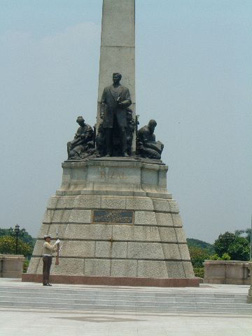Fabulous Philippines > Manila > Rizal Monument, Manila
Rizal Monument
Manila
Share this page:
Located at the western end of Rizal Park is the Rizal Monument which contains the mortal remains of Dr Jose Rizal, the national hero of the Philippines, who was executed near here by a firing squad under orders of the Spanish colonial authorities on December 30, 1896.
The Rizal Monument is guarded 24 hours a day, 365 days a year, by honor guard sentries standing stiffly to attention.

Honor Guard, Rizal Monument, Manila
On one side of the Rizal monument is a marble plaque marking the exact spot where the hero met his death.
The Monument consists of a bronze statue of Rizal standing and dressed in an overcoat and holding a book in his hand (the books are said to represent Rizal's novels Noli Me Tangere and El filibusterismo).
Behind the statue of Rizal is a marble obelisk. It rises to a height of 12.7 metres (42 feet). The obelisk is topped with a pyramid (said to represent Rizal's Masonic beliefs) and decorated with three stars (said to represent the three main geographical regions of the Philippines, Luzon, the Visayas, and Mindanao).
On one side of Rizal's statue is a statue of a mother and her child; on the other side is a statue of two boys reading. These statues are said to represent respectively family and education.
Rizal's statue is set upon a pedestal in which the hero's remains are interred. On the front of the pedestal is a plaque that reads (in English): "To the memory of Jose Rizal, patriot and martyr, executed on Bagumbayan Field [now Rizal Park] December thirtieth 1896. This monument by the people of the Philippine Islands."
Not far from the Rizal Monument is a plaque inscribed with the words of Rizal's final poem Mi Ultimo Adiós (My Final Farewell) in the Spanish, Tagalog, English and other languages; a life-sized diorama of Dr Rizal's execution; and a stone fountain from Ulm, Germany, where Rizal studied as a student.
Son et lumiere (sound and light) shows take place every evening, first in Tagalog and then in English, that re-enact the events of Dr Rizal's trial and death.
History of the Monument
Somewhat ironically the Rizal Monument was planned and constructed during what some see as another period of Filipino subjugation, the early years of the American colonial period.
Certain American officials had read and appreciated Rizal's articles and books and they realized the the importance of Rizal to the Filipino people.
In 1901 the United States Philippine Commission decided that a memorial to Jose Rizal be built and it passed Act No. 243 that allocated for that purpose the use of public land near where Rizal had fallen during his execution by the Spanish in 1896.
The Act also specified that the memorial should include a statue of the hero and that it would be the final resting place for his remains.
Finally the Act set up a committee to fund the project mainly through public subscriptions. The committee consisted of:
• Pascual Poblete (Filipino writer and feminist and first translator of Rizal's Noli Me Tangere into Tagalog)
• Paciano Rizal (the hero’s brother)
• Juan Tuason
• Teodoro R. Yangco (Filipino businessman, philanthropist and "father of the YMCA in the Philippines")
• Mariano Limjap (Chinese-Filipino businessman, patriot and philanthropist)
• Máximo Paterno (Secretary of Public Works and Communications during the First Philippine Republic)
• Ramón Genato
• Tomás G. del Rosario (attorney at the Philippine Bar)
• Ariston Bautista (Filipino physician, patriot, philanthropist and patron of the arts)
An international design competition was held in the period 1905-07. Entries came from 40 sculptors in Europe and the United States. The first prize was won by the Italian sculptor, Carlos Nicoli for his plaster cast model named Al Martir de Bagumbayan (To the Martyr of Bagumbayan); but the contract finally ended up being awarded to the Swiss sculptor, Richard Kissling, who had gained second place in the competition for his entry name Motto Stella (Guiding Star).
The Rizal Monument was finally completed and unveiled on December 30, 1913 (exactly 17 years since Jose Rizal had passed away).
As stipulated, the remains of the hero had been laid to rest under the pedestal of the Monument. Fortunately the remains of Jose Rizal had survived to allow a respectful reburial under the Rizal Monument. After the execution the remains of the hero had been secretly buried in the Paco Cemetery but fortunately their location was soon tracked down by Rizal's sister Narcisa – the full story is here).
In 1961 (100 years after the year of birth of Rizal) a huge stainless steel flagpole was added to the Monument, taking the height from 12.7 meters to 30.5 meters. The change was very unpopular as the gleaming steel was felt to be incompatible with the original somber granite base and the height of the flagpole was felt to dwarf the statue of Jose Rizal. Fortunately good sense prevailed and the flagpole was removed two years later.
Share this page:
Author: David Paul Wagner
(David Paul Wagner on Google+)
|